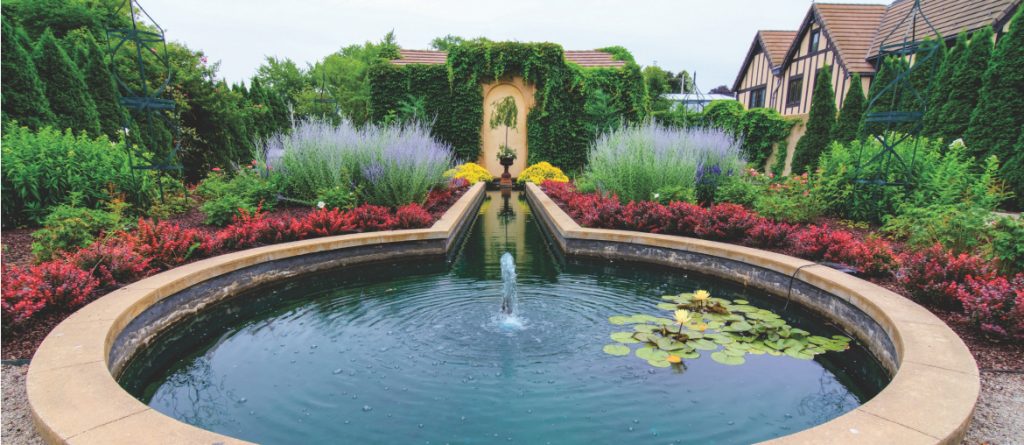Some of the earliest evidence of man’s desire to create inspiring outdoor plant-based spaces can be found in 16th-century Egyptian tomb paintings. While Wisconsin’s history of landscape architecture doesn’t date back quite that far, we aren’t lacking in historic gardens. Those below are sure to inspire.
Black Point Estate and Gardens, Lake Geneva
BACKSTORY: This sprawling lakeside estate was the dream of Chicago beer baron Conrad Seipp and was a summer home for the Seipp family for generations. It’s viewed by experts to hold one of the most intact collections of Victorian life in the Midwest.
WHAT YOU’LL FIND: In addition to a tour of the house, walks of the newly restored woodland gardens are now available. The look of the scenic gardens is in a similar style to the estate’s original plan, but within a smaller footprint. Bordered by a wide variety of hostas and hydrangeas, visitors can imagine lawn games being played at the turn of the twentieth century. Near the mansion, the color palette is soft with pinks and purples. As you move away, annuals and perennials become brighter.
IF YOU GO: The only way to access the estate is by boat with the Lake Geneva Cruise Line, although access for motorcoach tours can be arranged. Tickets are $39 for adults, $37 for seniors and $27 for children.
MORE TO DO: Back in Lake Geneva, there are plenty of places to eat and shop. Extreme green thumbs might want to walk the Lake Geneva Shore Path west from Library Park to the edge of Glanworth Gardens. Also known as the Richard Driehaus Estate for the venture capitalist who purchased and restored it, the gardens viewable from the Shore Path are spectacular in summer. The original landscape was designed by the Olmsted brothers, of New York City’s Central Park fame.Though you cannot stray off the path and onto the property, there is plenty to take in from the shoreline.
Paine Art Center and Gardens, Oshkosh
BACKSTORY: Built for Nathan Paine and Jessie Kimberly Paine, construction started on this elegant English country-style estate in the 1920s and concluded in 1947. The estate opened to the public in 1948. Nathan made his fortune in lumber and Jessie was the daughter of the co-founder of Kimberly-Clark. From the start, the Paine’s goal was to design an elegant estate, showcasing exceptional architecture, furnishings and art, which would be open to the public for educational and cultural pursuits. The Paines never lived here, but built this for public consumption.
WHAT YOU’LL FIND: The Paine estate features twenty garden areas—like an herb, formal and rose garden. Native trees, shrubs and wildflowers are also on display. Bulbs and annuals also change each year for new and exciting vistas.
IF YOU GO: Summer hours from 6/22 to 9/22 are 10 a.m. to 4 p.m., open daily. (Before 6/22 and after 9/22, the gardens and estate are open Tuesday through Sunday, 11 a.m. to 4 p.m.) Tickets are $9-$12 for adults and $5 for children.
MORE TO DO: Oshkosh is a city of surprises, and host to a number of local cafés and restaurants. Worth checking out is Brooklyn Grill on South Main Street. The building dates to the 1800s and the atmosphere exudes the 1940s.
West of the Lake Gardens, Manitowoc
BACKSTORY: Ruth St. John West and John Dunham West were wealthy business owners and philanthropists in Manitowoc, a charming community on Lake Michigan. It was mostly Ruth’s doing that turned six acres of quack grass and thistle into the beautiful flower gardens now known as the West of the Lake Gardens. Once a streetcar right-of-way, this lakefront space was purchased by the Wests in 1934. Ruth, along with the couple’s gardener, hand-spaded all six acres and planted 200 tulips. By the 1950s, the tulip count exceeded 30,000—a tulip for almost every man, woman and child in Manitowoc today.
WHAT YOU’LL FIND: Over time, the garden was redesigned to include ongoing color. You can’t tiptoe through the tulips today, but you will find an Eastern influence, a sea of roses and begonias, and an intricate web of raised beds all on the lakefront. In total about 18,000 annuals are planted in the garden every year.
IF YOU GO: The gardens are free and open to the public from Memorial Day through Labor Day weekend, from 10 a.m. to 5 p.m. daily, weather permitting.
MORE TO DO: The garden is a great secret, to be sure. So, too, is the Mariner’s Trail that goes right past it. A seven-mile, paved, lakeshore trail, it joins Manitowoc and Two Rivers and is open to bicyclists, walkers, joggers and skaters. If you get to West of the Lake Gardens via Mariner’s Trail, you’ll also be able to take in native lakefront flora and fauna and view public art along the trail. The trail will also take you to lighthouses and restaurants.
Photo by Eric Reischl Photography
This article originally appeared in the 2019 spring/summer issue of Experience Wisconsin magazine. The contents of this article were checked for accuracy when it was published; however, it’s possible some of the information has changed. We recommend you call first if you have specific questions for the destinations, attractions or restaurants mentioned in this article.
No portion of this article or magazine may be reproduced without prior written permission by the publisher.

